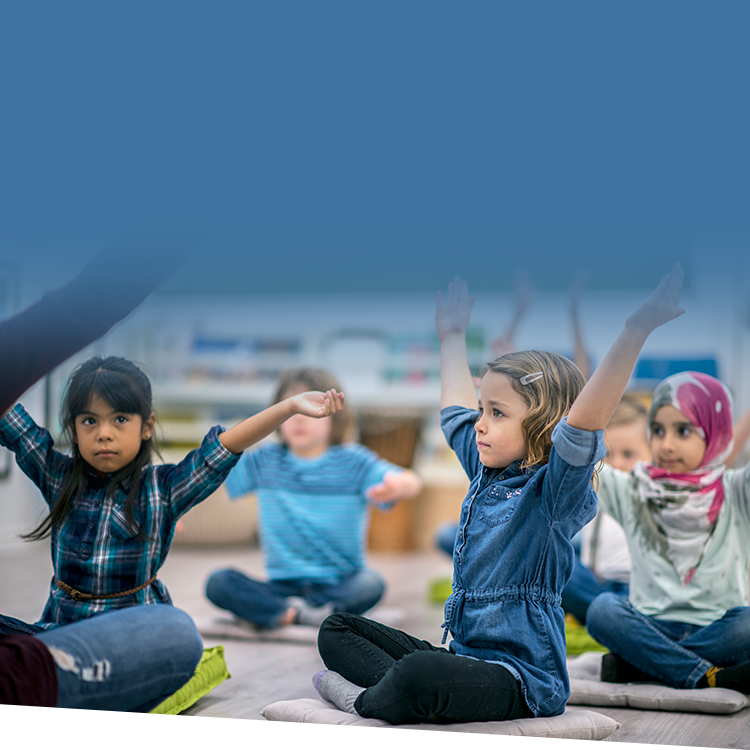In recent years, mindfulness in the classroom—sometimes referred to as “contemplative pedagogy”—has gained traction as a way to reduce stress and anxiety in students as well as to improve academic and behavioral outcomes. The COVID-19 pandemic continues to challenge our learning systems, with school closures, remote learning, physical distancing guidelines, and other unexpected changes negatively affecting children's mental health. Now more than ever, it is prudent for educators to apply evidence-based strategies that counterbalance the negative emotions that might otherwise thwart student progress.
Fight or Flight?
The brain’s amygdala—the integrative center for emotions, emotional behavior, and motivation—can mistake stress for danger, and when it does so, it can trigger a “fight-or-flight” response that disrupts the prefrontal cortex’s ability to regulate voluntary actions like reasoning, thinking, movement, decision-making, and planning.
Often referred to as an “amygdala hijack,” this can lead to aberrant and inappropriate conduct that has both academic and social consequences. It is an automatic response that can be prevented by a conscious effort to deactivate the amygdala while simultaneously activating the frontal lobes. The frontal lobes are the part of the brain responsible for rational, logical thinking.
Recognizing, acknowledging, and mitigating anxiety as it escalates is paramount to prevent the maladaptive behavior that derails learning and leads to embarrassment and regret. Meditation can weaken the functional connectivity between the amygdala and prefrontal cortex while simultaneously strengthening those connections between areas associated with contemplation and concentration.
What Is Mindfulness?
Mindfulness is a form of meditation that hones your ability to be fully present, aware of where you are and what you are doing while also maintaining control over your emotions. In general, it has been thought to reduce stress, enhance performance, increase insight and awareness through observation of one’s own mind, and increase one’s consideration of others’ well-being.
In the classroom, mindfulness-training can positively impact attention and focus, cognitive performance, emotional and social intelligence, memory, and perfectionistic tendencies. Taking a few minutes each day to encourage students to “check in” with themselves provides them with an opportunity to reflect on and regulate their current mental and emotional state.
Mindfulness practices benefit teachers as well—especially since it reduces stress and burnout, enhances efficacy, and increases the ability to maintain a more organized and emotionally supportive classroom environment. Experts agree that the best implementation of mindfulness involves a teacher having their own mindfulness practice or at least an understanding of what mindfulness entails.

Tune in to ask questions related to this Source article or other topics you've encountered lately.
Visit our NEW Community and start posting.
Using Mindfulness to Empower
Ultimately, the goal is for students to cultivate their own mindfulness—not simply to introduce it as an extra task. They must believe they have the capacity to be present not by changing who they are, but by employing scientifically backed techniques that demonstrate benefits to well-being.
To this end, there are various strategies to teach and practice in the classroom. Students can also leverage these strategies outside of school to assist them in managing stress. These include:
- Color breathing: Guide students to think of a color that invokes feelings of happiness or calm, and another color that represents negative emotion, such as anger, worry, or sadness. Ask the students to close their eyes and imagine they are breathing in the relaxing color, letting it fill their entire bodies. Then, on the exhale, invite them to picture the “negative” color leaving their body and dissolving into the air.
- The Five Senses Countdown: Use this countdown activity during moments of stress to help students calm their minds by using their five senses to focus on their environment instead of their thoughts. First, they notice five things that they can see, followed by four things that they can feel, three things that they can hear, two things that they can smell, and one thing that they can taste.
- Body Scan: Have students lie on the floor with their hands and arms placed slightly apart from their bodies. (It is better if they close their eyes, but it’s okay if they prefer to look at the ceiling instead.) Encourage them to pay attention to their feet for 5-10 seconds. Then tell them to move their focus on to their toes, ankles, calves, and knees. Continue to focus on each body part until they reach the heads, asking them how each part of the body feels by bringing their awareness to their bodies and the moment. If they feel any tightness, tell them to imagine breathing the stress out of that part of the body with each exhalation. By asking questions, such as “How do your feet feel?”, or “Are your fingers cold or warm?” can focus students’ attention and amplify the benefits.
- Daily gratitudes: Set aside five minutes to have students reflect on things they feel thankful for, using pictures or words, and then share either as a class or with a partner.
Mindful Momentum
Mindfulness is a powerful tool that assists with academic, social, and emotional learning, but also strengthens students’ ability to self-regulate and build resilience. It takes them beyond managing symptoms of stress to developing deeper human capacities that support their healthy development. By establishing educational environments in which mindfulness creates stability and safety, students can learn to calm their nervous systems, focus their attention, work with their emotions, and cultivate curiosity and openness to the world around them.





